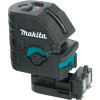Makita SK104Z Makita SK104Z Instruction Manual - Page 11
Hazards in use, Electromagnetic Compatibility EMC, FCC statement applic. in U.S. - test
 |
View all Makita SK104Z manuals
Add to My Manuals
Save this manual to your list of manuals |
Page 11 highlights
Responsibilities of the person in charge of the instrument: The person in charge of the instrument has the following duties: • To understand the safety instructions on the product and the instructions in the User Manual. • To be familiar with local safety regulations relating to accident prevention. Hazards in use ƽ CAUTION: Watch out for erroneous measurements if the instrument is defective or if it has been dropped or has been misused or modified. Carry out periodic test measurements. Particularly after the instrument has been subject to abnormal use, and before, during and after important measurements. Refer to section "Checking the accuracy". ƽ WARNING: Flat batteries must not be disposed of with household waste. Care for the environment and take them to the collection points provided in accordance with national or local regulations. The product must not be disposed of with the household waste. Dispose of the product appropriately in accordance with the national regulations in force in your country. Always prevent access to the product by unauthorised personnel. ƽ WARNING Using a battery charger not recommended by Makita can destroy the batteries. This can cause fire or explosions. Precautions: Only use chargers recommended by Makita to charge the batteries. Electromagnetic Compatibility (EMC) ƽ WARNING: The SK104 conforms to the most stringent requirements of the relevant standards and regulations. Yet, the possibility of it causing interference in other devices cannot be totally excluded. FCC statement (applic. in U.S.) This equipment has been tested and found to comply with the limits for a Class B digital device, pursuant to part 15 of the FCC Rules. These limits are designed to provide reasonable protection against harmful interference in a residential installation. This equipment generates, uses and can radiate radio frequency energy and, if not installed and used in accor- Makita SK104 11 Safety instructions en GB F I E P NL DK S N FIN J CN ROK PL HR H RUS CZ GR LT LV EST SLO SK M TR












